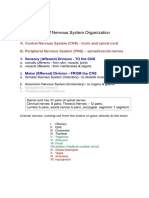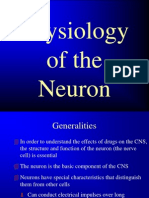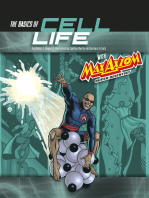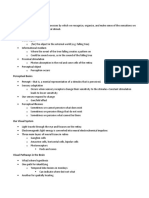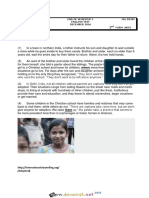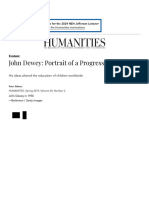The Cells of The Nervous System: Neurons and Glia
The Cells of The Nervous System: Neurons and Glia
Uploaded by
Arcanus LorreynCopyright:
Available Formats
The Cells of The Nervous System: Neurons and Glia
The Cells of The Nervous System: Neurons and Glia
Uploaded by
Arcanus LorreynOriginal Description:
Original Title
Copyright
Available Formats
Share this document
Did you find this document useful?
Is this content inappropriate?
Copyright:
Available Formats
The Cells of The Nervous System: Neurons and Glia
The Cells of The Nervous System: Neurons and Glia
Uploaded by
Arcanus LorreynCopyright:
Available Formats
The Cells of the Nervous System
Neurons and Glia
Two kinds of cell in the nervous system
Neurons – receive information and transmit it to other cells
Glia – serve many functions
the human brain contains approximately 86 billion neurons on average
Santiago Ramon y Cajal, a Pioneer of Neuroscience
one of the main founders of neuroscience
imprisoned for the crime of not paying his Latent class
wanted to become an artist but his father insisted him to study medicine; become an
anatomical researcher and illustrator
his detailed drawings of the nervous system are still considered definitive today
he used Golgi’s methods (silver salts) on the infant’s brain
demonstrated that nerve cell remained separate instead of merging from one another
The Structure of an Animal Cell
Plasma Membrane – surface of a cell; a structure that separates the inside of the cell from the
outside environment
Nucleus – (except for mammalian red blood cells) the structure that contains the chromosomes
Mitochondrion – structure that perform metabolic activities, providing the energy that the cell
uses for all activities
o Have genes separate from those nucleus in the cell
Ribosomes – site within a cell that synthesize new protein molecules
Endoplasmic Reticulum – a network of thin tubes that transport newly synthesized proteins to
other location
The Structure of a Neuron
Have long branches extensions
All neurons include a soma (cell body), and most also have dendrites, an axon, and presynaptic
terminals.
Motor Neuron – with its some in the spinal cord, receives excitation through its dendrites and
conducts impulses along its axon to a muscle
Sensory Neuron – specialized at one end to be highly sensitive to a particular type of
stimulation, such as light, sound, or touch.
Dendrites – branching fibers that gets narrower near their ends (comes from the greek word
“tree”)
o Lined with specialized synaptic receptors, at which the dendrites receives information
from other neurons
o Many dendrites contain dendritic spines – short outgrowths that increase the surface
area available for synapse
Cell body or Soma – contains the nucleus, ribosomes, and mitochondria
o Most of neuron’s metabolic rate occurs here
Axon – thin fiber of constant diameter (comes from the greek word “axis”)
Most vertebrae axons are covered with an insulating material called myelin sheath with
interruptions known as nodes of Ranvier. Invertebrate axons don’t have myelin sheath.
Presynaptic Terminal – swelling branch at the end of the axon; aka end bulb or bouton
Afferent axon – brings information into a structure
Efferent axon – carries information away from the structure
Interneuron or Intrinsic Neuron – if a cell dendrites and axons are entirely contained within a
single cell structure
Variations among Neurons
Vary enormously in brain, size, and function
The shape of a neurons determine its connection with other cells and thereby determines its
function
Gila (or neuroglia)
Derived from the Greek word meaning “glue”, reflects early investigators’ idea that glia were
like glue that held the neurons together.
Glia outnumber neurons in the cerebral cortex, but neurons outnumbered glia in several other
brain areas, especially the cerebrum. Overall, the numbers are almost equal.
There are several types of Glia
Astrocytes (star-shaped) – wraps around the synapses of functionally related axons. By
surrounding a connection between neurons, an astrocytes shields it from chemical circulating in
the surrounds. It is important for generating rhythms such as your rhythm of breathing.
Microglia – tiny cells that act as part of the immune system, removing viruses and fungi from
the brain.
Oligodendrocytes in the brain spinal cord and Schwann Cells in the periphery of the body build
the myelin sheaths that surround and insulate certain vertebrate axons. Also supply an axon
with nutrients necessary for functioning.
Radial Glia – guide the migration of neurons and their axons and dendrites during embryonic
development.
The Blood-Brain Barrier
The mechanism that excludes most chemicals from the vertebrate brain
Why do we need a Blood-Brain Barrier?
Extrude virus particles through the membrane so that the immune system can find them to kill it
and the cell that contains it.
However, certain viruses do cross the blood-brain barrier. It infects the brain and leads to death.
When rabies virus invades the blood-brain barriers-leads to death.
Microglia-fights the virus without killing the neurons
Chicken pox virus enters spinal cord cells, viruses merge from the spinal cord decades causing
painful condition called SHINGLES
How the Blood Brain Barrier Works?
Depend on endothelial cells (form the wall of the capillaries)
Cells are separated by small gaps (in the brain they are joined so tightly)
Useful chemicals (fuels and amino acids-the building blocks for proteins)
For these chemical to cross the blood brain barrier, the brain needs special mechanism.
Most large molecules and electrically charged molecules cannot cross from the blood to the
brain.
Oxygen and Carbon dioxide cross easily, a scan certain fat-soluble molecules. Active transport (a
protein-mediated process that expends energy pump chemicals from the blood into the brain)
systems pump glucose and amino acids across the membrane.
Most cells use a variety of carbohydrates
Vertebrae neurons depend almost entirely on glucose
(cancer cells and the testes cells that make sperm also rely on glucose)
Metabolizing glucose requires oxygen
Glucose is the only nutrient that crosses the blood barrier in large quantities. To use glucose the
body needs Vitamin B1, thiamine. Prolonged thiamine deficiency (common among those who
are alcoholic) leads to death of neurons or Korsakoff’s syndrome, marked by severe memory
impairments
RESTING POTENTIAL OF THE NEURON
All parts of a neuron are covered by a membrane about 8 nanometers (nm) thick.
The membrane is composed of two layers ( free to float relative to each other) of
o Phospholipid molecules -containing chains of fatty acid. Embedded among phospholipid
are cylindrical protein molecules through which certain chemicals can pass
o Phosphate group
THE MEMBRANE OF THE NEURON
Embedded in the membrane are protein channels that permit certain ions to cross through the
membrane at a controlled rate
THE RESTING POTENTIAL
POLARIZATION – a difference in electrical charges between inside and outside of the cell
The electrical potential inside the membrane is slightly negative with respect to the outside
o (because of negatively charged proteins inside the cell. The sodium-potassium pump
movessodium ions out of the neuron, and potassium ions.)
Resting potential – difference in voltage
FORCES ACTING ON SODIUM AND POTASSIUM IONS
Selective permeability – Some chemicals pass through it more freely than others do.
o like oxygen,carbon dioxide ,urea and water cross freely through channels that are
always open
o Sodium, potassium,calcium and chloride ,cross thru mermbrane channels that are
sometimes open and closed.
When the membrane is at rest what happened?
When a channel open, it permits some type of ion to
cross the membrane. When it closes, it prevents
passage of that ion .
FORCES ACTING ON SODIUM AND POTASSIUM IONS
THE SODIUM - POTASSIUM PUMP – a protein complex repeatedly transports three sodium ions
of the cell while drawing two potassium ions into it.
o It is an active transport that requires energy.
o Effective only because of selective permeability of the membrane.
o When the neuron is at rest , two forces act on Sodium
1. Consider the electrical gradient. Sodium is positively charged, and the inside
is negatively charged ( this makes pull the sodium into the cell-opposite
electrical charges attract)
2. Consider the concentration gradient -the difference in distribution of ions
across the membrane
o Potassium is subject to potassium forces
o Potassium is positively charged and the inside of the cellis negatively charged, electrical
gradient tends to pull potassium in.
o If the potassium channels were wide open, potassium would have a small net flow out
of the cell.
Sodium ions are more concentrated outside the neuron,
and potassium ions more concentrated inside. Protein
and chloride ions ( not shown) bear negative charges
inside the cell. At rest ,almost no sodium ions cross the
membrane except by the sodium-potassium pump.
Potassium tends to flow into the cell because of an
electrical gradient but tends to flow out because of the
concentration gradient. However ,potassium gates
retard the floe of potassium when membrane is at rest.
THE ACTION POTENTIAL
ACTION POTENTIAL – When the membrane is sufficiently depolarized to each cell's threshhold,
sodium and pottassium channels open. Sodium ions enter rapidly ,reducing and reversing the
charge across the membrane.
Increasing the negative charge inside the neuron may change it into:
o hyperpolarization-increase polarization
THE ALL OR NON- LAW
The amplitude and velocity of an action potential are independent of the intensity of the
stimulus that initiated it.
THE MOLECULAR BASIS OF THE ACTION POTENTIAL
1. At the start, sodium ions are mostly outside the neuron, and potassium ions are mostly inside.
2. When the mebrane is depolarized,sodium and potassium channels in the membrane open.
3. At the peak of the action potential ,the sodium channels close
ACTION POTENTIAL
After the peak of the action potential, the membrane returns toward its original level of
polarization because of the outflow of potassium ions.
PROPAGATION OF THE ACTION POTENTIAL
This describes the transmission of an action potential down an axon. The propagation of an
animal species is the production of offspring.
At first the opening of potassium channels produces little effect
Opening sodium channels lets sodium ions rush into the axon
Positive charge flows down the axon and opens voltage sodium channels at the next point
At the peak of the action potential, the sodium gates snap shut. They remain closed for the next
millisecond or so despite of the polarization of the membrane
Because voltage -gated potassium channels remain open ,potassium ions flow out of the axon,
returning the membrane towards its original depolarization
A few milliseconds later, the voltage -dependent potassium channels close.
The Myelin Sheath and Saltatory Conduction
In axons that are covered with myelin, action potentials form only in the nodes that separate
myelinated segments. Transmission in mylinated axons is faster than unmyelinated
Myelin- an insulating materialcomposed of fats and protein
Myelinated axon- those covered with myelin sheath
Nodes of Ranvier short section of axon
LOCAL NEURONS
Local neurons – Neurons without an axon exchange information with only their closest
neighbors
Because they do not have an axon, they do not follow the all or non-law
When local neurons receives information from other neurons it has graded potential
Graded potential – a membrane potential that varies in magnitude in proportion to the intensity
of the stimulus
You might also like
- Biological Psychology 12th Ed. Chapter 1Document3 pagesBiological Psychology 12th Ed. Chapter 1sarahNo ratings yet
- Scribd Download - Google Search - HTMLDocument60 pagesScribd Download - Google Search - HTMLDennis WelchNo ratings yet
- Cell Membrane Mitochondria "Organelles"Document6 pagesCell Membrane Mitochondria "Organelles"Ashraf MobyNo ratings yet
- Chapter 1 Nerve Cells and Nerve Impulses 2Document19 pagesChapter 1 Nerve Cells and Nerve Impulses 2REPALDA, Irish N.No ratings yet
- CHAPTER 3 - Cells in Nervous System NotesDocument15 pagesCHAPTER 3 - Cells in Nervous System NotesOfeliaNo ratings yet
- 10 NeuroDocument16 pages10 NeuroAriol ZereNo ratings yet
- Unit 2 - Structure and Functions of The CellsDocument12 pagesUnit 2 - Structure and Functions of The CellssindhusivasailamNo ratings yet
- 1Document5 pages1nab3lhakeem2021No ratings yet
- 2. NeuronDocument36 pages2. Neuronalimohsin0907No ratings yet
- 10 Neuro PDFDocument16 pages10 Neuro PDFKamoKamoNo ratings yet
- Group 9 Neuron Structure & FunctionDocument14 pagesGroup 9 Neuron Structure & FunctionMosesNo ratings yet
- Chapter 3 Biological Foundations of BehaviourDocument20 pagesChapter 3 Biological Foundations of BehaviourAlex LiNo ratings yet
- Chapter 2 NeuronDocument49 pagesChapter 2 NeuronAfNo ratings yet
- Complete Download of Biological Psychology Kalat 12th Edition Solutions Manual Full Chapters in PDF DOCXDocument37 pagesComplete Download of Biological Psychology Kalat 12th Edition Solutions Manual Full Chapters in PDF DOCXkasanoteczli100% (3)
- Unit 2 BiopsychDocument22 pagesUnit 2 Biopsychgetaravindh11No ratings yet
- Unit I Fundamentals of Biomedical Engineering Cell and Its StructureDocument30 pagesUnit I Fundamentals of Biomedical Engineering Cell and Its Structureanon_193775053No ratings yet
- 0nerve Muscle Physiology NewDocument48 pages0nerve Muscle Physiology NewYogesh DravidNo ratings yet
- The Action of Nerves: Appendix 4Document4 pagesThe Action of Nerves: Appendix 4natjeros12No ratings yet
- Lecture 1Document14 pagesLecture 1Mahreen NoorNo ratings yet
- The Nervous SystemDocument5 pagesThe Nervous SystemStephen YorNo ratings yet
- Physio CH-2Document24 pagesPhysio CH-2aliraza67570No ratings yet
- Autonomic Nervous SystemDocument19 pagesAutonomic Nervous SystemAnuvabNo ratings yet
- Lecture 2Document37 pagesLecture 2Ahmed G IsmailNo ratings yet
- Nervous System I: Basic Structure and FunctionDocument4 pagesNervous System I: Basic Structure and Functionrohit100% (1)
- Neurological Control of MovementDocument25 pagesNeurological Control of MovementKarma MiaNo ratings yet
- Summary Biological PsychologyDocument133 pagesSummary Biological PsychologyAnastasia100% (1)
- Human Anatomy and Physiology Lecture Notes - Nervous System Human Anatomy and Physiology Lecture Notes - Nervous SystemDocument34 pagesHuman Anatomy and Physiology Lecture Notes - Nervous System Human Anatomy and Physiology Lecture Notes - Nervous SystemLilyNo ratings yet
- The Nervous System: Neurons Nervous and Endocrine SystemsDocument10 pagesThe Nervous System: Neurons Nervous and Endocrine SystemsKirat SinghNo ratings yet
- Assignment Briefing 2Document33 pagesAssignment Briefing 2lengers poworNo ratings yet
- Nerve and Its Function PDFDocument26 pagesNerve and Its Function PDFJose albert MauanayNo ratings yet
- Anatomy and Physiology of The NerveDocument18 pagesAnatomy and Physiology of The NervejudssalangsangNo ratings yet
- PL3102 NotesDocument8 pagesPL3102 NotesKatriel HeartsBigbangNo ratings yet
- Human Anatomy and Physiology Lecture Notes Nervous SystemDocument39 pagesHuman Anatomy and Physiology Lecture Notes Nervous Systemsam peligroNo ratings yet
- Topic 8 Grey MatterDocument17 pagesTopic 8 Grey Mattersakhawut06No ratings yet
- Neurons and The Action PotentialDocument3 pagesNeurons and The Action PotentialnesumaNo ratings yet
- BadfishDocument8 pagesBadfishMelisa SanchezNo ratings yet
- Chapter 2 NeuronDocument49 pagesChapter 2 NeuronNithinNo ratings yet
- Lecture 3: Biological Basis of Behavior 1: Cell StainingDocument8 pagesLecture 3: Biological Basis of Behavior 1: Cell StainingT-Bone02135100% (1)
- Electrical Properties of NeuronsDocument8 pagesElectrical Properties of NeuronsswarooprnayakaNo ratings yet
- Prinsip Kerja Sistem SarafDocument25 pagesPrinsip Kerja Sistem SarafIzzuddin FathoniNo ratings yet
- Chapter 3a - Nerve PhysiologyDocument36 pagesChapter 3a - Nerve Physiologyferidhusen2016No ratings yet
- Instant download Biological Psychology Kalat 12th Edition Solutions Manual pdf all chapterDocument49 pagesInstant download Biological Psychology Kalat 12th Edition Solutions Manual pdf all chapterpiratasutej100% (1)
- Macroglia+Neuron ASG 16-01-2023 PDFDocument9 pagesMacroglia+Neuron ASG 16-01-2023 PDFRajat AgrawalNo ratings yet
- Chapter 48 ReviewDocument5 pagesChapter 48 ReviewamtholeNo ratings yet
- Neurons & SynapsesDocument126 pagesNeurons & SynapsesXi En LookNo ratings yet
- Unit 2 Biology and BehaviourDocument26 pagesUnit 2 Biology and BehaviourNeel RanjanNo ratings yet
- Tutorial 4.3Document5 pagesTutorial 4.3Rosa FinizioNo ratings yet
- The Biological Perspective 1Document18 pagesThe Biological Perspective 1Radhey SurveNo ratings yet
- Resting Membrane PotentialDocument22 pagesResting Membrane PotentialSanchezNo ratings yet
- PHC 513 Flipped Class QuestionDocument17 pagesPHC 513 Flipped Class QuestionALISYA SOPHIA MOHAMMAD ABU SHAHID CHRISNo ratings yet
- 123Sc1 Resting and Action PotentialDocument22 pages123Sc1 Resting and Action PotentiallexixashantiNo ratings yet
- Neurons and Neuroglia - PPTX 2nd LecDocument23 pagesNeurons and Neuroglia - PPTX 2nd Leczaraali2405No ratings yet
- Human Physiology: Nervous SystemDocument27 pagesHuman Physiology: Nervous Systemaalishaayoob23No ratings yet
- Structure of The Nervous SystemDocument7 pagesStructure of The Nervous Systema7a mdrNo ratings yet
- Anatomy and Physiology of The NeuronDocument80 pagesAnatomy and Physiology of The NeuronFelix LupulescuNo ratings yet
- Cell Structure: Rebecca MaynardDocument11 pagesCell Structure: Rebecca Maynardbecki93No ratings yet
- Biophypsy M1L3Document3 pagesBiophypsy M1L3Maria Helen PalacayNo ratings yet
- Neurones (Sample Lesson 3)Document5 pagesNeurones (Sample Lesson 3)ELOISA CASANENo ratings yet
- Neuro PsychologyDocument23 pagesNeuro PsychologyKavya tripathiNo ratings yet
- The Basics of Cell Life with Max Axiom, Super Scientist: 4D An Augmented Reading Science ExperienceFrom EverandThe Basics of Cell Life with Max Axiom, Super Scientist: 4D An Augmented Reading Science ExperienceNo ratings yet
- Spen D: Borro WDocument4 pagesSpen D: Borro WArcanus LorreynNo ratings yet
- M3. Human FreedomDocument3 pagesM3. Human FreedomArcanus LorreynNo ratings yet
- Purely Formal PaintingsDocument4 pagesPurely Formal PaintingsArcanus LorreynNo ratings yet
- Main Functions of Attention: Signal Present Absent Present AbsentDocument7 pagesMain Functions of Attention: Signal Present Absent Present AbsentArcanus LorreynNo ratings yet
- The Method in Teaching EthicsDocument2 pagesThe Method in Teaching EthicsArcanus LorreynNo ratings yet
- M1. Introduction To Cognitive Psychology: Philosophical AntecedentsDocument5 pagesM1. Introduction To Cognitive Psychology: Philosophical AntecedentsArcanus LorreynNo ratings yet
- Module 2.1 The Concept of The SynapseDocument4 pagesModule 2.1 The Concept of The SynapseArcanus LorreynNo ratings yet
- Visual PerceptionDocument6 pagesVisual PerceptionArcanus LorreynNo ratings yet
- M4 - JungDocument5 pagesM4 - JungArcanus LorreynNo ratings yet
- Rizal: Life of Rizal: 21 CenturyDocument1 pageRizal: Life of Rizal: 21 CenturyArcanus LorreynNo ratings yet
- I I R A Ia R J: Lesson 4: AmortizationDocument4 pagesI I R A Ia R J: Lesson 4: AmortizationArcanus LorreynNo ratings yet
- Devoir de Synthèse N°1 - Anglais - 2ème Lettres (2016-2017) Mme Besma DZIRIDocument4 pagesDevoir de Synthèse N°1 - Anglais - 2ème Lettres (2016-2017) Mme Besma DZIRISassi LassaadNo ratings yet
- A Dream of Stars and Darkness - Madeleine EliotDocument241 pagesA Dream of Stars and Darkness - Madeleine Eliotlzosia.24.09100% (1)
- Quiz PMIDocument66 pagesQuiz PMImohammed ouahid100% (1)
- Web Systems and Technologies 1: 2 Semester - SY 2020-2021Document16 pagesWeb Systems and Technologies 1: 2 Semester - SY 2020-2021Masha RosaNo ratings yet
- Ethical Issues in Assisted Reproductive Technologies ART 2Document49 pagesEthical Issues in Assisted Reproductive Technologies ART 2Pavan chowdaryNo ratings yet
- Untitled DocumentDocument3 pagesUntitled DocumentchesNo ratings yet
- Defendants' Motion To DismissDocument35 pagesDefendants' Motion To DismissKenan FarrellNo ratings yet
- Delta Green RPG Character Sheet CopDocument2 pagesDelta Green RPG Character Sheet CopHuck BursoNo ratings yet
- Two Essential Add Ons For The Bitx40Document4 pagesTwo Essential Add Ons For The Bitx40Jonathan Rea100% (1)
- The Mining Act 2016 - Simplified Version 1102020 003 - 220603 - 112712Document32 pagesThe Mining Act 2016 - Simplified Version 1102020 003 - 220603 - 112712Justus AmitoNo ratings yet
- Citiizen's Charter of The Provincial Government of South CotabatoDocument111 pagesCitiizen's Charter of The Provincial Government of South CotabatoXyrilloid Mercado LandichoNo ratings yet
- Escala CooperDocument15 pagesEscala CooperJudithZlotsky100% (1)
- John Deere 9540 9560 9580 9640 9660 9680 Wts Cws Combines Operator Manual EnDocument24 pagesJohn Deere 9540 9560 9580 9640 9660 9680 Wts Cws Combines Operator Manual Encrascolimani5qNo ratings yet
- Arnold Arnez - COMP Folklore ProposalDocument2 pagesArnold Arnez - COMP Folklore ProposalArnold ArnezNo ratings yet
- BPF System OverviewDocument80 pagesBPF System OverviewSmart GuyNo ratings yet
- Teen Abuse LeafletDocument9 pagesTeen Abuse LeafletAfiah SafinatunnajahNo ratings yet
- Branch ColorsDocument7 pagesBranch ColorsG LiuNo ratings yet
- New Dokument Programu Microsoft WordDocument5 pagesNew Dokument Programu Microsoft WordZuzana ŠimkováNo ratings yet
- File Cbse Class 10 Imp Q Triangles 1583492715Document7 pagesFile Cbse Class 10 Imp Q Triangles 1583492715ShanmugasundaramNo ratings yet
- Answer 1: CDocument34 pagesAnswer 1: CRUPAM GHOSHNo ratings yet
- 1 - Scheme+ Syllabus BE CSE 13.08.2020Document25 pages1 - Scheme+ Syllabus BE CSE 13.08.2020ritikNo ratings yet
- John Dewey - Portrait of A Progressive Thinker - The National Endowment For The HDocument23 pagesJohn Dewey - Portrait of A Progressive Thinker - The National Endowment For The Hqawsed24680No ratings yet
- 40 Best Exercises To Increase HeightDocument51 pages40 Best Exercises To Increase HeightGaudencio BoniceliNo ratings yet
- Walmart: Smiling Around The World: Presented by Group 3Document24 pagesWalmart: Smiling Around The World: Presented by Group 3Chester FernandesNo ratings yet
- Dungeonographer Pro QuickstartDocument21 pagesDungeonographer Pro QuickstartJuan Perdomo AguiarNo ratings yet
- Basic Economic Ideas-MinDocument7 pagesBasic Economic Ideas-MinShenal De SilvaNo ratings yet
- Article WritingDocument2 pagesArticle WritinghyftzdgffNo ratings yet
- VisionIAS PT 365 February 2024 EconomyDocument104 pagesVisionIAS PT 365 February 2024 Economymodern.amuNo ratings yet










































